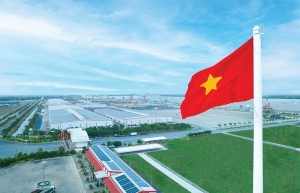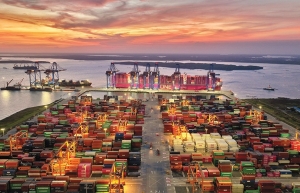Logistics infrastructure can enjoy a bright future
How do you evaluate the development of Vietnam’s logistics infrastructure over the past few years?
Infrastructure is a critical enabler of the logistics industry’s potential. With the support of the Party and government, we have seen an increase in large-scale projects. Notably, for the first time, the private sector has invested in airports.
Additionally, Vietnam now has three seaports ranked among the top 50 largest container seaports globally, and many new highways have been built. Looking ahead, there are policies in place for investment in high-speed railway systems.
Beyond transport infrastructure, there has been significant development in warehouses and logistics centres. In recent years, the number of warehouses in Vietnam has surged, with many modern facilities incorporating automation technology to enhance handling capacity. These are examples of hard infrastructure.
In terms of soft infrastructure, IT, workforce development, and the legal environment are essential factors. Logistics companies are making significant strides in these areas to enhance their business activities.
 |
| Tran Thanh Hai, deputy director of the Agency of Foreign Trade under the Ministry of Industry and Trade |
Could you shed some light on inland waterway infrastructure?
Inland waterways play a crucial role in enhancing connectivity, particularly between the north-south regions and the Mekong Delta.
Development has been stronger in the south, although the infrastructure, including ports, remains basic and far behind that of seaports. Challenges include narrow passages, sedimentation, and hydrological issues.
In the north, some progress has been made following the opening of the Nghia Hung Canal last year, which links waterways from Haiphong to the north-central region, including Ninh Binh and Thanh Hoa. This has boosted the inland waterway sector and supported the logistics services industry.
From the perspective of a state management agency, what is your view on the lack of synchronisation in logistics infrastructure connectivity?
Several factors contribute to high logistics costs, including infrastructure, administrative procedures, and the capabilities of businesses.
A significant issue is the lack of synchronisation in logistics infrastructure. Infrastructure investment in the logistics and transportation sectors has been limited, though recent efforts towards modernisation are aligning with global trends.
Vietnam is currently building the Long Thanh airport, which is expected to handle 100 million passengers annually. However, its potential as an international transshipment hub has not yet been fully realised. In terms of seaport investments, we are expanding Lach Huyen and developing new facilities like the Can Gio international transshipment port. These projects create vast opportunities in the seaport sector, positioning it as a bright spot in infrastructure development and supporting Vietnam’s integration.
For inland waterways, investments are increasing after years of decline. The growth of expressways is also notable, though the standards for expressways, such as the minimum number of lanes, are still being refined to ensure efficiency.
Many businesses have expressed frustration with lengthy procedures for logistics infrastructure investment. What is your view on this, and what are the solutions to remove issues?
We understand the challenges investors face. One company said that after selecting a construction site, they encountered time-consuming and costly processes to change land use purposes and complete procedures to build a logistics centre or inland clearance port. This can dampen their enthusiasm and hinder project progress.
The Ministry of Industry and Trade is studying these issues for inclusion in the draft development strategy for Vietnam’s logistics industry, which will be submitted to the government. We have identified several factors to help the industry gain momentum and develop more rapidly.
The strategy will focus on removing institutional bottlenecks to ensure smooth investment and business operations. By completing the legal framework, we can clear obstacles to the development and investment in logistics infrastructure.
 | Logistics supply chain efficiency on the rise The expanding consumer market, with abundant supply and a favourable geographical location for penetration and network expansion, is pushing Vietnam’s logistics supply chain to increase efficiency. |
 | Connectivity a factor in positive results of logistics companies Port operators and shipping lines continue to record a robust performance in 2024, reflecting the vibrant potential of Vietnam’s logistics market. Dang Huy Hoang, research analyst at VNDirect Securities, shared with VIR’s Vy Bui the current performance data of Vietnamese logistics companies. |
 | Long-term funds to address logistics cost Vietnam’s logistics industry is rapidly developing, but high costs remain a barrier to unlocking the full potential of the country’s digital economy and e-commerce market. |
What the stars mean:
★ Poor ★ ★ Promising ★★★ Good ★★★★ Very good ★★★★★ Exceptional
Related Contents
Latest News
More News
- Pivotal stage of growth paves way for rise in M&As (December 03, 2025 | 10:00)
- Positive projections for M&A interest from Thailand (December 03, 2025 | 09:40)
- Manifesting the first line of defence in cybersecurity (December 03, 2025 | 09:00)
- The transformational role AI can play in accounting arena (December 03, 2025 | 08:00)
- Unlocking 5G-AI potential in Singapore (December 03, 2025 | 08:00)
- Data-driven strategies vital for a fast-evolving nation (December 02, 2025 | 09:41)
- Policy to practice: how Vietnam can lead the region (November 26, 2025 | 16:03)
- Mobilising private capital at scale vital for climate battle (November 26, 2025 | 15:36)
- VILAF and Yoon & Yang launch Vietnam - Korea Practice Unit (November 26, 2025 | 15:16)
- Trademark disputes challenge foreign firms in Vietnam (November 24, 2025 | 15:30)

 Tag:
Tag:





















 Mobile Version
Mobile Version